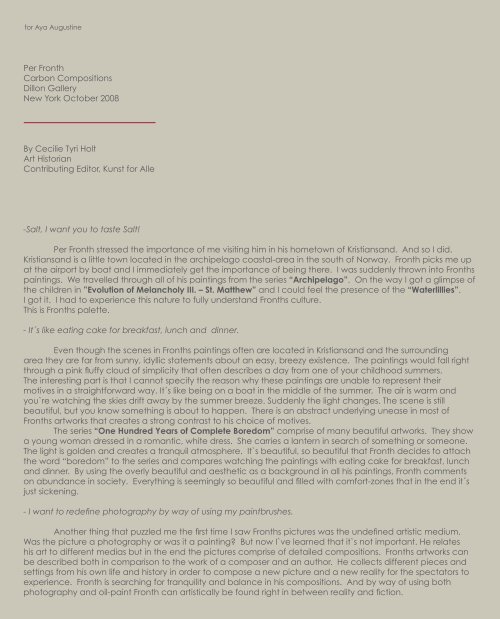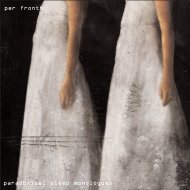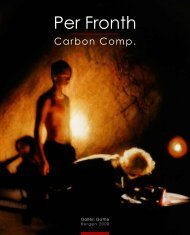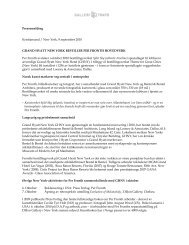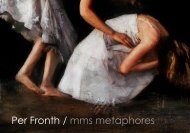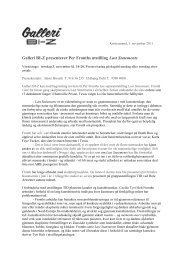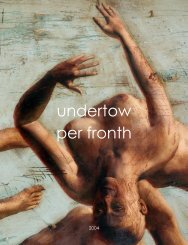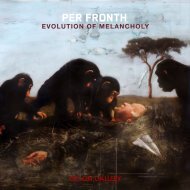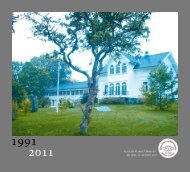Per Fronth
Per Fronth
Per Fronth
You also want an ePaper? Increase the reach of your titles
YUMPU automatically turns print PDFs into web optimized ePapers that Google loves.
for Aya Augustine<br />
<strong>Per</strong> <strong>Fronth</strong><br />
Carbon Compositions<br />
Dillon Gallery<br />
New York October 2008<br />
By Cecilie Tyri Holt<br />
Art Historian<br />
Contributing Editor, Kunst for Alle<br />
-Salt, I want you to taste Salt!<br />
<strong>Per</strong> <strong>Fronth</strong> stressed the importance of me visiting him in his hometown of Kristiansand. And so I did.<br />
Kristiansand is a little town located in the archipelago coastal-area in the south of Norway. <strong>Fronth</strong> picks me up<br />
at the airport by boat and I immediately get the importance of being there. I was suddenly thrown into <strong>Fronth</strong>s<br />
paintings. We travelled through all of his paintings from the series “Archipelago”. On the way I got a glimpse of<br />
the children in ”Evolution of Melancholy III. – St. Matthew” and I could feel the presence of the “Waterlillies”.<br />
I got it. I had to experience this nature to fully understand <strong>Fronth</strong>s culture.<br />
This is <strong>Fronth</strong>s palette.<br />
- It´s like eating cake for breakfast, lunch and dinner.<br />
Even though the scenes in <strong>Fronth</strong>s paintings often are located in Kristiansand and the surrounding<br />
area they are far from sunny, idyllic statements about an easy, breezy existence. The paintings would fall right<br />
through a pink fluffy cloud of simplicity that often describes a day from one of your childhood summers.<br />
The interesting part is that I cannot specify the reason why these paintings are unable to represent their<br />
motives in a straightforward way. It´s like being on a boat in the middle of the summer. The air is warm and<br />
you`re watching the skies drift away by the summer breeze. Suddenly the light changes. The scene is still<br />
beautiful, but you know something is about to happen. There is an abstract underlying unease in most of<br />
<strong>Fronth</strong>s artworks that creates a strong contrast to his choice of motives.<br />
The series “One Hundred Years of Complete Boredom” comprise of many beautiful artworks. They show<br />
a young woman dressed in a romantic, white dress. She carries a lantern in search of something or someone.<br />
The light is golden and creates a tranquil atmosphere. It`s beautiful, so beautiful that <strong>Fronth</strong> decides to attach<br />
the word “boredom” to the series and compares watching the paintings with eating cake for breakfast, lunch<br />
and dinner. By using the overly beautiful and aesthetic as a background in all his paintings, <strong>Fronth</strong> comments<br />
on abundance in society. Everything is seemingly so beautiful and filled with comfort-zones that in the end it´s<br />
just sickening.<br />
- I want to redefine photography by way of using my paintbrushes.<br />
Another thing that puzzled me the first time I saw <strong>Fronth</strong>s pictures was the undefined artistic medium.<br />
Was the picture a photography or was it a painting? But now I`ve learned that it`s not important. He relates<br />
his art to different medias but in the end the pictures comprise of detailed compositions. <strong>Fronth</strong>s artworks can<br />
be described both in comparison to the work of a composer and an author. He collects different pieces and<br />
settings from his own life and history in order to compose a new picture and a new reality for the spectators to<br />
experience. <strong>Fronth</strong> is searching for tranquility and balance in his compositions. And by way of using both<br />
photography and oil-paint <strong>Fronth</strong> can artistically be found right in between reality and fiction.<br />
- I want my works to be about life not art.<br />
The search or the quest seem to be a continuous theme in many of <strong>Fronth</strong>s pictures. Like the girl<br />
with the lantern in “One Hundred Years of Complete Boredom / Scandinavia”, the boys, and the girl, in the<br />
enormous picture called “Bridge / Teenage Lux” are also carriers of light. But what are they searching for?<br />
“Bridge / Teenage Lux” is reminiscent of a film-still. The scene is from a view common to <strong>Fronth</strong>.<br />
Ever since he was a little boy growing up in Kristiansand he used to fish for crayfish and crab. I do not know<br />
how often New Yorkers ever see young boys fishing for crayfish and crab though. Even this everyday scene, at<br />
least for Norwegians in the summertime, <strong>Fronth</strong> makes into something oblivious and abstract. The picture tells a<br />
story not only about a summer activity but it is also loaded with symbolic meaning. The number three is<br />
repetitive in the three boys, three poles and the three “svabergs”, a Norwegian term best described in English<br />
as slopes of naked rocks polished by receding glaciers during the last ice-age 10.000 years ago.<br />
Numerology is a system that has a link to Judaism, Hinduism, Christianity and other religions. The belief<br />
that there is a connection between numbers and living things are interpreted differently by every religion.<br />
According to christian numerology the number of three is a symbol of completeness mainly because of the<br />
Holy Trinity. We also find examples of the importance of the number of three in the division of time into the<br />
concepts of past, present and future. The aspect of time seems to be of great importance in regards to the<br />
division of the picture “Bridge / Teenage Lux” into sort of a triptych. The triptych has a history that stems from<br />
early christian art and altar paintings from the Middle ages.<br />
<strong>Fronth</strong> composes and divides his pictures in his characteristically bold way. He actually leaves the<br />
middle of “Bridge / Teenage Lux” totally black. The middle of the picture is thus dominated by a big, black<br />
shadow. This is a quite dramatic way to divide the picture into three parts that can symbolise the past, present<br />
and the future.<br />
The picture is so beautifully accomplished that my eyes slowly wander in circles over the canvas. It`s<br />
kind of like watching a Caravaggio because of <strong>Fronth</strong>s choice of colours and the use of strong chiaroscuro.<br />
It also reminds me of the Norwegian painter Christian Krohgs (1852-1925) “Albertine i Politilægens<br />
Venteværelse” from 1887. The latter comparison because of <strong>Fronth</strong>s way of experimenting with the spectators<br />
glance and the pictures theatrical aspect.<br />
In his time Christian Krohg was an artist who combined photography and painting in a new way.<br />
He also challenged the idea of where the focal-point in the paintings should be. In “Albertine” he tells the sad<br />
story of a young girl that is forced into prostitution. But it is not Albertine the spectator first sees in the painting<br />
because someone else is occupying the middle of the canvas. Just like <strong>Fronth</strong>s big shadow in the middle of<br />
“Bridge / Teenage Lux”. In Krohgs painting the real action or the real story is being told in the background of<br />
the scene. The spectator is being asked to see the entire frame and the spectators glance is being compelled<br />
to move in Krohgs famous painting. This is also the case in <strong>Fronth</strong>s “Bridge / Teenage Lux”.<br />
By using chiaroscuro, a term that describes the strong contrasts in baroque paintings, <strong>Fronth</strong> creates a<br />
dramatic scene. It seems as if these boys are searching for something or someone in the water. Water is often<br />
regarded as a symbol of life. Hence the picture can be interpreted as the youths searching for the<br />
meaning of life. The bridge may symbolise the turning-point and the connection between the past and the<br />
future, between childhood and adulthood. The lighthouse may symbolise the one thing that´s constant and<br />
unfaltering in everyone’s life. That lighthouse symbolises of course a million different things to a million<br />
different people. Some believe in a God, some believe in the kindness of other people etc. The lighthouse<br />
means whatever you want it to mean.<br />
In addition to placing <strong>Fronth</strong> in relation to retrospective art history, one can also regard him as<br />
representing a photographic expression and experimentation that is similar to other contemporary artists like<br />
Mike & Doug Starn (1961-) or Jeff Wall (1946-). The German photographer Andreas Gursky (1955-) also creates<br />
huge photographic compositions of different kinds of space, often without any people in it. If there is people in<br />
the photographs, their purpose is to form a pattern rather that to function as individuals or symbols. One never<br />
gets to know the people in Gurskys photographs. Unlike the people in <strong>Fronth</strong>s art works, they`re just pieces that<br />
together form great compositions. Gurskys photographs, like <strong>Fronth</strong>s art work, pieces together a new reality.<br />
Gurskys art is thus similar to <strong>Fronth</strong>s artistic consept, but far glossier. <strong>Fronth</strong> makes the fact that his art works<br />
comprise of different parts quite visible to the naked eye, while Gursky do not show the seams at all.<br />
Nevertheless, it`s interesting to see how <strong>Fronth</strong> reacts artistically to other contemporary artists that base their<br />
work on the photographic medium.


